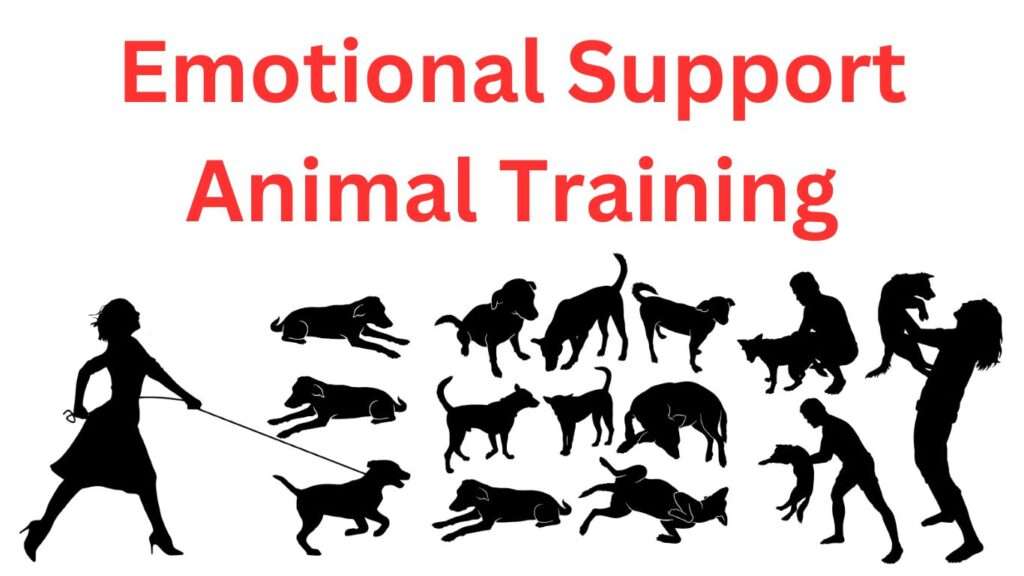Emotional Support Animal Training
There is a distinct and remarkable kind of hero in the realm of fur and feathers.
They don’t wear capes or have superhuman strength, but they do have something more fundamental – the ability to mend shattered hearts, calm anxious minds, and bring peace to those in need.
Our wonderful Emotional Support Animals (ESAs) are these unsung heroes.
If you’ve ever enjoyed sharing your life with an ESA, you’ll understand the inexplicable comfort they provide in times of need.
They are partners who stand with us during life’s emotional storms, delivering a calming presence and unflinching support.
But, behind those beautiful eyes and wagging tails, a journey is often overlooked: the path of training.

Does ESA Need Training?
Training is not mandatory for emotional support animals, it is a proactive step towards assuring the comfort and legality of your ESA in a variety of situations.
Training your Emotional Support Animal (ESA) is an important step in securing not just your own access rights, but also the well-being of your canine partner.
While the Air Carrier Access Act and the Fair Housing Act do not specifically require ESA training, choosing it freely can substantially speed up the process and increase societal acceptance.
As a professional pet trainer, I strongly advise training your ESA for several convincing reasons.
For starters, a well-trained ESA is less likely to exhibit disruptive or anxious behavior in public places or in shared living, eliminating possible confrontations and assuring a more pleasant experience for you and others.
It will ease the process of getting an ESA letter without any objection. ESA letter is a primary document to live or travel with your pet.
Moreover, an obedient ESA can promote social acceptance because people are more likely to welcome and assist well-mannered and under-control animals.
The Importance of Training
Emotional Support Animals (ESAs) play an important part in the lives of those who are dealing with emotional and mental health issues.
They provide company, comfort, and support when it is most needed.
Having an ESA, however, is more than just offering cuddles and warmth; it is also about ensuring they are well-trained to do their duty properly.
Go through the top ten reasons why training your Emotional Support Animal is critical.
1- Enhanced Bonding
Training is more than just learning instructions; it’s a wonderful method to develop your bond with your ESA.
Training time together creates trust, understanding, and a deeper connection.
2- Behavioral Control
Proper training instills in your ESA discipline and control.
This control is necessary in a variety of contexts, including public locations and dealing with specific triggers at home.
3- Social Adaptability
ESAs who have received proper training are better suited to deal with social circumstances.
They are more adaptable to new situations, people, and animals, decreasing stress for both you and your pet.
4- Public Acceptance
A trained ESA is more likely to be accepted in public places because they are less likely to cause disruptions or endanger others.
5- Emotional Regulation
ESAs are intended to aid in emotional regulation.
A skilled ESA can provide more effective comfort and support, assisting you in dealing with anxiety, depression, or other emotional issues.
6- Safety Assurance
Training assures that your ESA will not behave aggressively or dangerously.
This not only protects others but also ensures the safety of your ESA in a variety of situations.
7- Compliance with Legal Requirements
Many countries and states have particular ESA legislation.
Training your ESA ensures compliance with these rules and helps to avoid potential legal complications.
8- Consistency in Support
A well-trained ESA can provide consistent emotional support.
They can predictably respond to your demands, which is critical for emotional stability.
9- Independence and Freedom
You get more independence when your ESA is well-trained.
You can confidently take them to numerous locations and engage in activities that benefit your mental health.
10- Reduced Stress
Finally, training your ESA relieves both of your tension.
A well-behaved ESA contributes to a more tranquil and helpful atmosphere by causing fewer disturbances and disagreements.
Summary
Finally, the value of training your Emotional Support Animal cannot be emphasized.
It’s not just about accepting directions; it’s also about improving your and your ESA’s quality of life.
Training your pet allows you to efficiently provide the emotional support you require, resulting in a harmonious and soothing attachment that can make a difference in your mental health journey.
So, put in the time and effort to train your ESA, and watch as it becomes an even more helpful partner on your journey to emotional well-being.
Explore effective pet training by reviewing either the comprehensive 777 rules or the succinct 10 Golden Rules, ensuring optimal guidance for enhancing your pet’s behavior.
Basic Obedience Training
There is an underlying link between Emotional Support Animals (ESAs) that transcends linguistic barriers.
Individuals facing emotional and mental issues often find comfort, understanding, and steadfast support from their four-legged pals.
This intimate connection, however, is not completely innate; it is cultivated via training.
Emotional Support Training It’s not just about making sure they obey directions; it’s about cultivating a connection based on trust and mutual understanding.
This round of our voyage into the realm of ESA training will concentrate on the foundation of it all – Basic Obedience Training.
Mastering Essential Commands
Emotional Support Animals (ESAs) are very special to us.
During our most difficult times, they bring comfort, friendship, and unflinching support.
However, training is essential for them to provide the greatest possible help.
Training your ESA goes beyond obedience; it strengthens your bond and increases your ability to help you in times of emotional distress.
In this round of our exploration of the realm of ESA training, we will look at ten important commands that every well-trained ESA should know.
These directives secure their safety while also increasing their confidence and dependability as emotional support partners.
1- Sit
“Sit” is one of the most basic orders.
It assists your ESA in being calm in a variety of settings, particularly when meeting new people or animals.
To teach this command, do the following:
- Bring a goodie up to their nose.
- Raise the treat gradually above their heads, prompting their bottom to naturally sink.
- As they sit, say “sit” and give them the goodie.
2- Stay
“Stay” is critical for the safety of your ESA, especially in potentially harmful situations.
To teach this command, do the following:
- Begin by placing your ESA in the “sit” position.
- Extend your hand with your palm out and say “Stay.”
- Take a breather.
- Reward and praise them if they remain sitting.
3- Come
The “come” command ensures that your ESA responds when you call it.
This is critical for their security and management in public places.
- Bring yourself down to their level, call out their name, and say “Come.”
- As they approach, give them praise and a treat.
- Experiment with this command in a variety of settings, gradually introducing distractions.
4- Down
The “down” command instructs your ESA to lie down peacefully, which is useful in crowded or stressful settings.
- Begin by placing your ESA in a “sit” position.
- Move a goodie towards the ground while holding it to their nose.
- Say “down” and reward them as they lie down.
5- Leave it
“Leave it” is essential for keeping your ESA from picking up or swallowing dangerous materials while out and about.
- Display a treat in your closed hand.
- When they attempt to examine or grab it, tell them to “leave it.”
- Once they’ve calmed down, give them a new goodie from your other hand.
6- Drop it
If your ESA has picked up something they shouldn’t have, the “drop it” command can help.
- Begin by putting a toy in their mouth.
- Provide a more enticing toy or food while saying, “Drop it.”
- Reward and praise them when they release the object.
7- Heel
During walks, the “heel” is useful for keeping control and preventing pulling.
- Start walking your ESA on a leash.
- When they begin to pull, say “heel” and come to a complete halt.
- Wait for them to rejoin you before continuing your trek.
See also: Dog Leash Training
8- Off
The command “off” instructs your ESA not to jump on people or things.
- Say “off” and gently push them down when they jump.
- When they comply, give them praise and rewards.
9- Wait
“Wait” is useful for controlling your ESA while approaching doorways, gates, or a street.
- When you come to a door or a crossroads, say “Wait.”
- Only proceed after they have waited patiently.
- Reward their perseverance.
10- Quiet
It is critical to teach “quiet” to prevent excessive barking, which can be disruptive.
- Say “quiet” when they start barking and wait for them to stop.
- Reward them for remaining silent.
Summary
Mastering these ten basic commands not only transforms your ESA into a well-behaved and dependable companion, but it also improves their ability to provide emotional support.
Remember that training should be a fun and fulfilling experience. Be patient, provide positive reinforcement, and customize your approach to the personality and needs of your ESA.
You’ll build your bond and create a more harmonious and helpful relationship with your cherished Emotional Support Animal with frequent training.
Socialization and Public Behaviour
Emotional Support Animals (ESAs) are more than simply pets; they are lifelines for people dealing with emotional and mental health issues.
In times of sorrow, their constant friendship provides solace and emotional support.
However, for ESAs to be effective in their responsibilities, they require more than just love; they must also be trained in socialization and public behavior.
This round of our voyage into the realm of ESA training delves into the fundamentals of socialization and public behavior, explaining why they are important and how to successfully traverse them.
Why Socialization Matters
Socialization is the process of exposing your ESA to a variety of surroundings, people, and circumstances to guarantee that they are comfortable and well-behaved in a variety of contexts.
1)- Confidence Building
Socialisation enhances the confidence of your ESA.
They become more adaptive and less apprehensive when they are exposed to a variety of environments and circumstances.
2)- Reduced Stress
An ESA who has been well-socialized is less likely to experience tension or anxiety in strange places or with new individuals.
3)- Behavioral Control
Socialisation teaches your ESA how to behave appropriately in a variety of situations, lowering the likelihood of undesired behavior.
Getting Started with Socialization
Socialization should begin as soon as your ESA is born.
It’s never too late to start, and it’s a continuing process. Here’s where to begin:
1- Start Small
Begin in tranquil, low-stress environments and then graduate to more difficult ones.
2- Positive Experiences
Make every socialization experience a positive one. When your ESA handles new settings effectively, reward them with goodies, praise, and affection.
3- Experiment with Different Stimuli
Introduce your ESA to new people, animals, noises, smells, and settings. This variety assists them in becoming well-rounded.
4- Consistency
Maintain consistency by including socialization into your ESA’s daily routine. Short, frequent outings are more beneficial than long, random ones.
5- Observe Their Level of Comfort
Pay attention to your ESA’s body language. Allow them time to adjust if they appear overwhelmed or anxious.
Public Behavior Training
Socialization is extended through public behavior training.
It focuses on how your ESA acts in different public places and scenarios.
Here are several critical points:
1)- Basic Obedience
Make sure your ESA consistently obeys simple orders like “sit,” “stay,” and “come,”, especially in public areas.
2)- Leash Training
Leash training is important. Your ESA should walk peacefully and without pulling on a leash. This keeps you and others comfortable.
3)- Meeting People and Animals
Teaching Your ESA to Interact Properly with Strangers and Other Animals.
Teach your ESA how to interact properly with strangers and other animals. This includes refraining from jumping on people and barking excessively.
4)- Distraction Reaction
Teach your ESA to remain attentive to you even in the presence of distractions. During training sessions, gradually introduce distractions.
5)- Behavior in Public Spaces
Your ESA should be well-behaved in public locations such as parks, stores, and public transit.
Make certain that they do not disrupt or inconvenience others.
Summary
Finally, socialization and public behavior training are critical components of ensuring your ESA can provide the emotional support you require in a variety of scenarios.
These abilities boost their confidence, alleviate stress, and make them trustworthy partners in both familiar and unusual situations.
Remember that training should be enjoyable for both you and your ESA. Be patient, give positive reinforcement, and enjoy each small step forward.
You may assist your ESA in becoming a well-socialized and well-behaved companion who stays solidly by your side on your emotional journey with devotion and consistency.
Advanced Training
Emotional Support Animals (ESAs) are companions who provide deep emotional support to persons struggling with mental health difficulties.
While ESAs have a natural propensity to provide comfort, advanced training can increase their effectiveness in assisting their human counterparts.
We’ll go into the world of advanced training for ESAs in this section, discussing the benefits, methodologies, and how to take your four-legged companion to the next level.
The Value of Advanced Training
ESA advanced training goes beyond basic obedience to improve their ability to provide emotional support.
Here are a few strong reasons why advanced training is priceless:
1- Better Behaviour
Advanced training refines a dog’s behavior, making it well-behaved and dependable in a variety of situations, including public areas.
2- Improved Communication
Advanced training enhances the link between the ESA and its owner, resulting in improved communication and comprehension.
3- Increased Confidence
Training increases an ESA’s confidence, allowing them to feel more at ease in a variety of situations.
4- Increased Adaptability
Advanced training prepares ESAs to deal with unexpected situations or triggers with elegance and composure.
5- Comprehensive Assistance
ESAs with advanced training can do specialized tasks to more effectively assist clients with disabilities or emotional issues.
Advanced Training Techniques
1)- Public Behavior Training
Public Behaviour Training focuses on teaching ESAs how to behave properly in public places, including as heeling on a leash, remaining calm in the presence of distractions, and following advanced directions.
2)- Task Training
ESAs can be trained to do things like guide visually impaired people, alert them to specific medical concerns, and provide deep pressure therapy during panic attacks.
3)- Task Interruption
This training teaches ESAs how to intervene in self-harming or emotional meltdowns by using calming tactics or physical pressure.
4)- Emotional Disturbance Recognition
ESAs can be taught to sense emotional distress or anxiety in their owners and respond accordingly by providing comfort and assistance.
5)- Complex Commands
Complex commands and actions are introduced in advanced training, such as collecting specified goods, opening doors, or offering medicine reminders.
6)- Advanced Socialisation
ESAs are trained to interact with a wide range of people and animals in a variety of settings, boosting flexibility and lowering anxiety.
Choosing the Right Training Program
When it comes to advanced training for your ESA, it is critical to select the correct program or trainer.
Here are some pointers:
1- Certified Trainers
Look for trainers who are certified in advanced ESA training or animal behavior.
2- Personalised Approach
Ensure that the program is tailored to the specific needs and difficulties of your ESA.
3- Positive Reinforcement
Choose positive reinforcement trainers since they are more effective and humane.
4- References and Reviews
Check for references and reviews from prior clients to get a sense of the trainer’s reputation.
5- Continuous Learning
Training is a constant process that requires continuous learning. Select a program that includes follow-up assistance and regular reviews.
Summary
Advanced training is a life-changing experience that increases your ESA’s ability to provide crucial emotional support.
You may enable your beloved companion to flourish in their vocation with patience, devotion, and the correct training program, making a significant impact in your life and the lives of people who rely on them for comfort and help.
Famous Training Techniques
Emotional Support Animals (ESAs) are wonderful companions who bring comfort, consolation, and support to people who are dealing with emotional or mental health issues.
These four-legged or winged companions must be trained to be successful ESAs.
Various training strategies have gained popularity over the years to assist ESAs in fulfilling their critical tasks.
In this blog post, we will look at five well-known training approaches that help ESAs be the best they can be.
1-Positive Reinforcement Training
The key principle is to reinforce desired behaviors by rewarding them with snacks, praise, or toys.
Why It Works
Positive reinforcement establishes a positive link between the behavior and the reward, prompting ESAs to perform well.
2- Clicker Training
The use of a clicker to offer instant feedback when an ESA demonstrates desired behavior, followed by a reward, is a key principle.
Why It Works
Clicker training provides accurate and timely communication, assisting ESAs in determining which activities result in incentives.
3- Operant Conditioning
Shaping behavior by reinforcing incremental steps toward a desired end is a key principle.
Why Does It Work?
It deconstructs complicated behaviors into manageable chunks, making it easier for ESAs to learn and trainers to recognize progress.
4- Desensitization and Counterconditioning
Key Principle: Exposing ESAs to triggers (such as loud noises or meeting new people) gradually and combining the trigger with good experiences.
Why It Works
By forming new, positive connections, this therapy assists ESAs in overcoming fear or anxiety connected with triggers.
5- Lure-and-Reward Training
The use of bait (typically a treat) to direct an ESA into the desired position or behavior, followed by rewarding them.
Why Does It Work?
It breaks down complex behaviors into small steps and assists ESAs in understanding what is required of them.
6- Target Training
Teaching ESAs to touch a specific object or target with their nose or paw to show compliance with a command is a key principle.
Why It Works
It gives ESAs a clear and practical means to express their comprehension and collaboration.
7- Classical Conditioning
The key principle is to affect behavior by pairing a neutral input (such as a sound or word) with a positive or negative occurrence.
Why Does It Work?
It elicits emotional reactions in ESAs, allowing them to identify certain stimuli with pleasant or negative events.
8- Task Training
Training ESAs to perform specific tasks that assist individuals with disabilities or emotional issues is a key principle.
Why It Works
Task training gives ESAs the abilities they need to provide critical support to their owners.
9- Bond-Based Training
The importance of the tie and connection between the ESA and the owner as the cornerstone of training.
Why It Works
A strong link pushes ESAs to please their owners and improves communication.
10- Behavior Modification
Change unwanted behaviors using approaches such as positive reinforcement, extinction, or punishment.
Why It Works
Specific difficulties are addressed via behavior modification strategies, allowing ESAs to become more well-behaved and reliable.
Summary
Training is an important part of preparing ESAs to do their jobs well.
These ten well-known training strategies provide a wide toolkit for ESA owners and trainers to choose from, based on their animal companions’ requirements and personalities.
Whether through positive reinforcement, behavior shaping, or task training, the goal remains the same.
To empower ESAs to provide the constant support and comfort that makes them invaluable companions for persons experiencing emotional or mental health issues.
Maintaining and Updating Training
Emotional Support Animals (ESAs) serve an important role in offering comfort, companionship, and emotional stability to people who are dealing with mental health issues.
ESA training is a continual process that grows in tandem with the changing needs of both the animal and its owner.
In this blog article, we’ll look at why an ESA’s well-being and efficacy must keep their training up to date regularly.
Why Training Maintenance Matters
Training an ESA is a continuous process, not a one-time event.
There are several strong reasons why training should be maintained and updated:
1- Adaptability
As the world changes, ESAs must adjust to new locations, situations, and individuals. Regular training updates help them stay adaptive and calm.
2- Consistency
To guarantee that your ESA continues to obey directions and behave properly, it is critical to reinforce their training regularly.
This uniformity is especially important in public places.
3- Physical Health
The physical capacities of ESAs may change as they mature.
Regular training updates can accommodate these changes while also ensuring the employees’ safety and well-being.
4- Emotional Well-Being
ESAs can go through emotional shifts as well. Regular training might assist in dealing with new worries or behaviors that may occur over time.
5- Compliance with Regulations
Laws and regulations governing ESAs are subject to change. Updating your ESA’s training assures compliance with the most recent legislative standards.
Key Aspects of Training Maintenance and Updates
Now that we’ve established the significance of continuing training, let’s look at some critical areas of maintaining and updating an ESA’s training:
1- Consistent Practise
Even brief training sessions assist in reinforcing past learning and teaching new commands or behaviors.
2- Evaluation
Assess your ESA’s behavior and skills regularly to find areas that may require development or change.
3- Socialisation
Continue to expose your ESA to new people, animals, and surroundings to keep their social skills sharp.
4- Advanced Training
Consider advanced training strategies such as public behavior training or specialized assignments to improve your ESA’s talents and adaptability.
5- Update Commands
Ensure that your ESA continues to respond successfully to basic commands, particularly in public situations.
6- Address New Challenges
If new behavioral issues occur, consult with a trained trainer or behaviorist to address them efficiently.
7- Keep Records
Keep a training journal to assess progress, identify areas for development, and document any behavioral changes.
Choosing the Right Trainer
Choosing the correct trainer or program for training maintenance and updates is critical:
1)- Certification
Ensure that the trainer is certified and has experience in ESA training or animal behavior.
2)- Personalization
Look for a trainer who can personalize training to the needs and challenges of your ESA.
3)- Positive Reinforcement
Choose positive reinforcement teachers who are more successful and humane.
4)- References
Check references and evaluations from former clients to determine the trainer’s reputation.
5)- Ongoing Support
Select a program that provides follow-up assistance and frequent reviews to track progress.
Training an ESA is a lifelong process that involves dedication, patience and a dedication to your furry companion’s well-being.
Handling Stress and Anxiety of Pet
Emotional Support Animals (ESAs) are more than simply pets; they are lifelines for those who are dealing with emotional or mental health issues.
These amazing animals provide us with comfort, companionship, and steadfast support when we need it the most.
However, becoming an ESA is not without its difficulties, particularly when it comes to dealing with stress and anxiety in our beloved animal companions.
In this episode of our trip into the world of ESA training, we will look at the critical component of understanding and resolving stress and anxiety in your pet.
Why Do ESAs Experience Stress and Anxiety?
ESAs, like people, can suffer stress and anxiety. Among the most common explanations are:
1)- Change in Routine
Sudden changes to their normal pattern can be upsetting.
This could be the result of a change in your schedule, living situation, or the addition of a new family member.
2)- Lack of Socialization
If your ESA has not been properly socialized, new people, animals, or situations can cause anxiety.
3)- Environmental Factors
ESAs can be overwhelmed by loud noises, unexpected environments, or crowded areas.
4)- Physical Discomfort or Illness
Physical discomfort or illness can cause anxiety in animals.
6)- Separation Anxiety
When away from their owners, ESAs can build deep connections and become worried.
Recognizing Signs of Stress and Anxiety
To effectively treat stress and anxiety in your ESA, you must first recognize the symptoms:
1)- Excessive Panting
Excessive panting can suggest stress.
2)- Shaking or Trembling
Physical shaking or trembling can be an indication of worry.
3)- Excessive Barking or Whining
If your generally calm ESA becomes vocal, this could be a symptom of concern.
4)- Destructive Behaviour
Stress can cause chewing, scratching, or other destructive behaviors.
5)- Avoidance
Your ESA may strive to avoid anxious people, places, or situations.
6)- Changes in Appetite or Sleep
Stress can have an impact on eating and sleeping habits.
7)- Hiding
When they are anxious, some ESAs may hide.
Addressing Stress and Anxiety
1- Make a Safe Zone
Provide a safe, peaceful spot for your ESA to retreat to when they are stressed or anxious. This could be a particular room or a comfortable crate.
2- Consistency and routine
Maintain a regular daily schedule. Anxiety can be reduced by eating regularly, exercising, and playing.
3- Socialization
Introduce new people, animals, and environments to your ESA gradually. Positive experiences can help to alleviate anxiety.
4- Training
Basic obedience training improves your ESA’s behavior while also increasing their confidence and decreasing nervousness.
5- Physical activity with mental stimulation
Engage your ESA in physical and cerebral stimulation regularly through play and interactive toys.
6- Items of Solace
Provide comfort objects that your ESA associates with security and relaxation, such as blankets or toys.
7- Seek Professional Advice
If your ESA’s tension and anxiety persist or worsen, get expert advice from a veterinarian or animal behaviorist.
8- Remedies or medication
In severe circumstances, your veterinarian may suggest natural remedies or medicines to help with anxiety relief.
Summary
Finally, identifying and dealing with tension and anxiety in your ESA is critical for their well-being and efficacy in giving emotional support.
You can assist your ESA in living a happy, healthy, and fulfilled life by seeing signs of stress, providing a safe environment, sticking to a routine, and getting professional advice when necessary.
Remember, just as your ESA is there for you when you need them, you must be there for them when they are stressed or anxious.
You may negotiate life’s problems and joys together, supporting each other on your shared journey.
Understanding and Managing Triggers
Emotional Support Animals (ESAs) give vital assistance to people dealing with emotional or mental health issues.
Their unconditional affection and companionship aid in the relief of anxiety, depression, and other forms of emotional pain.
However, to be the greatest help they can be, they must first understand and manage triggers.
This episode of our ESA training trip will dig into the critical aspects of recognizing and handling triggers that may impact your furry pet.
What Are Triggers?
Triggers are events or situations that provoke intense emotional responses in people and are frequently associated with traumatic experiences or specific anxieties.
Triggers can emerge in a variety of ways in the setting of ESAs, ranging from behavioral concerns to increased anxiety. Common ESA triggers may include:
1- Loud Noises
Fireworks, thunderstorms, or construction noise are examples of loud noises.
2- Crowded Places
Congested areas include shopping malls, airports, and public transportation.
New Humans or Animals: Strangers, unusual pets, or aggressive animals.
3- Routine Changes
Changes in daily routines or settings.
4- Separation Anxiety
The fear of being alone for long periods.
Recognizing Triggers in Your ESA
Recognizing triggers as a caring ESA owner is critical to understanding and resolving your companion’s emotional well-being.
Here are some indicators that your ESA may be experiencing triggers:
1- Aggressive Behavior
Growling, barking, or snapping when exposed to a specific stimulus is considered aggressive behavior.
2- Avoidance
Attempting to flee or hide from the trigger.
3- Panting or trembling excessively
Physiological responses to stress or terror.
4- Destructive Behavior
Chewing, digging, or scratching as a coping method is an example of destructive behavior.
5- Changes in Body Language
Restlessness, elevated hackles, or pinned-back ears are examples of changes in body language.
Managing Triggers in Your ESA
Once you’ve discovered the triggers that impact your ESA, you must take proactive efforts to properly manage them:
1- Gradual Exposure
In a controlled and positive environment, gradually expose your ESA to the trigger.
Treats and praise should be used to reward calm behavior.
2- Counterconditioning
Combine the trigger with pleasant memories.
If your ESA is terrified of thunder, for example, offer treats and play during a storm to develop good connections.
3- Desensitisation
Expose your ESA to the trigger at a level that they can manage gradually.
As they get more comfortable, gradually increase the intensity or length of exposure.
4- Professional Training
Work with a qualified animal behaviorist or trainer who has expertise working with ESAs to create a customized desensitization plan.
5- Establish Safe Zones
Establish a safe zone where your ESA can retreat when presented with stimuli. Make sure this area is relaxing and pleasant.
6- Maintain a Consistent Routine
A consistent daily routine can bring comfort and predictability to your ESA.
7- Medication or Herbal Remedies
Consult your veterinarian about medication or herbal remedies that can help ease anxiety and manage triggers in extreme cases.
8- Avoidance When Necessary
Avoiding known triggers may be the best solution in some instances. Consider offering a peaceful, pleasant location during fireworks displays, for example, if your ESA is afraid of fireworks.
Summary
Understanding and managing triggers is a critical component of ESA training.
You may empower your ESA to thrive despite their triggers by recognizing the indicators of triggers, using tactics like progressive exposure and counterconditioning, and getting expert support when necessary.
Remember that the most powerful tools for assisting your ESA in overcoming their triggers are patience, love, and understanding.
You can strengthen your link and create an environment where both you and your furry companion can find comfort and support on your shared journey if you work together.
Resources and Support
Emotional assistance Animals (ESAs) are wonderful companions who provide essential emotional assistance to people coping with mental health issues.
Training an ESA to be productive and well-behaved is a journey that necessitates direction, tools, and assistance.
In this blog post, we’ll look at the several tools available to assist you in training and caring for your ESA so that they can perform to the best of their abilities.
The Importance of Resources and Support
Training and caring for an ESA can be a rewarding but difficult endeavor.
Here are some of the reasons why having access to resources and help is critical:
1- Education
Resources provide useful knowledge about ESA rules, training methods, and animal care, enabling owners to make informed decisions.
2- Training Guidance
Training guides, videos, and manuals provide step-by-step instructions and ideas for properly training ESAs.
3- Professional Help
Support from certified trainers and behaviorists can address specific issues and guarantee your ESA receives expert advice.
4- Community and Peer Support
Connecting with other ESA owners through forums, groups, or support networks can provide emotional support and shared experiences.
Key Resources for ESA Owners
Certified Trainers: Certified ESA trainers and animal behaviorists can give individualized training programs as well as expert advice.
1- Online Training Courses
A variety of websites and platforms provide extensive ESA training courses, which are frequently delivered by certified trainers.
2- Training Manuals and Books
Books such as “The Complete Guide to ESA Training” and “Training Your Emotional Support Animal” provide in-depth information about training procedures.
3- YouTube and Video Tutorials
Many trainers and professionals post ESA training videos on YouTube, making strategies easier to grasp and practice.
4- ESA Forums and Support Groups
Online communities such as ESA-specific forums or social media groups can connect you with other ESA owners and share training advice.
5- Local Training Classes
Look for local obedience or dog training classes that can aid with basic obedience and socialization.
6- Legal Resources
It is critical to understand ESA laws and regulations. Websites such as the ADA’s official webpage or legal resources will help you understand your rights and duties.
Tips for Accessing Resources and Support
Here are some pointers for finding and utilizing ESA training materials and support:
1- Research Thoroughly
Thoroughly study trainers, courses, or resources to ensure they meet the needs of your ESA and your training objectives.
2- Seek Professional Help
If you are experiencing unique training difficulties or behavioral issues, consult a trained trainer or behaviorist.
3- Network with Other ESA Owners
Connect with other ESA owners to share experiences, tips, and resource recommendations.
4- Stay Informed
To safeguard your rights and duties as an ESA owner, keep up to current on ESA legislation and regulations.
5- Practice Patience
Patience is a virtue to cultivate because training takes time and perseverance. Throughout the process, be patient with both your ESA and yourself.
Resources and support are critical components of effective ESA training and treatment.
Summary
They provide you with the knowledge, skills, and direction you need to develop your ESA into a dependable and effective partner.
By utilizing the abundance of available resources and requesting assistance when necessary, you empower your ESA to give consistent emotional support that may make a significant impact in your life and the lives of those who rely on them.
Common Challenges and Solutions
Emotional Support Animals (ESAs) have a particular place in the hearts of individuals who rely on them for emotional support and comfort.
They are companions that provide important support during times of mental hardship, not just pets.
However, training an ESA can be a rewarding but difficult experience.
In this part, we’ll look at some of the most typical issues that arise during Emotional Support Animal training and offer practical strategies to solve them.
Challenge 1: Distractions in Public Places
Solution: Gradual Exposure and Desensitization
For ESAs, public environments can be overwhelming, with numerous distractions vying for their attention.
To overcome this obstacle, begin exercising in peaceful areas and progressively increase distractions.
Increase the intensity of stimulation as your ESA grows more comfortable. Consistent practice will assist them in remaining focused in public areas.
Challenge 2: Fear or Anxiety
Solution: Positive Reinforcement and Patience
Some ESAs may experience worry or terror, which might impede their training progress.
Patience is essential in this situation. Use positive reinforcement tactics to create a safe training environment.
Reward little measures towards overcoming their concerns while avoiding overburdening them.
If the nervousness persists, seek the advice of a competent trainer who has worked with anxious animals.
Challenge 3: Inconsistency in Commands
Solution: Establish Clear Communication
Inconsistency in commands used by different family members or carers can cause your ESA to become confused.
To remedy this issue, ensure that everyone involved in the care of your ESA is on the same page.
To avoid confused signals, use unambiguous, consistent commands and procedures.
Challenge 4: Stubbornness or Resistance
Solution: Adapt Training Methods
ESAs, like people, have personalities and peculiarities. Some people may be more resistant to training than others.
Adapt your training approaches if you meet resistance. Experiment using several methods, be patient and provide tempting rewards to stimulate your ESA.
Challenge 5: Reinforcing Undesirable Behaviors
Solution: Redirect and Replace
Reinforcing bad behaviors unintentionally can stymie your ESA’s training progress. Focus on redirection and replacement to avoid this.
When your ESA exhibits undesired behavior, refocus his or her attention on appropriate behavior and reward it instead. Breaking bad behaviors requires consistency.
Challenge 6: Impatience
Solution: Set Realistic Expectations
Training takes time, and being impatient can stymie development.
Set reasonable expectations and acknowledge that each ESA is unique. Celebrate tiny triumphs along the way, and take your time.
Training is a continuous process, not a destination.
Challenge 7: Environmental Distractions
Solution: Controlled Training Environments
External issues like as loud noises or unexpected locations can pose difficulties for ESAs.
Choose regulated areas where you can manage distractions when training. As your ESA gains confidence, gradually introduce new elements.
Challenge 8: Lack of Professional Guidance
Solution: Consult a Certified Trainer or Behaviorist
If you’re having trouble training your ESA, don’t be afraid to seek professional help.
Certified trainers and animal behaviorists can offer customized solutions and expert advice to solve specific situations.
Challenge 9: Overtraining or Fatigue
Solution: Maintain Short, Frequent Sessions
Long, strenuous workouts can cause weariness and declining rewards.
To sustain your ESA’s attention and excitement, keep training sessions brief and frequent. This method is more efficient and fun for you and your buddy.
Challenge 10: Regression in Behavior
Solution: Revisit Basic Training
Consider redoing fundamental training sessions if your ESA exhibits a behavioral regression.
Going back to basics can sometimes help reinforce positive behavior and recover confidence.
FAQs
Does an Emotional Support Animal (ESA) require formal training like a service animal?
No, ESAs do not require the intensive training that service animals do. Basic obedience and decent behavior, on the other hand, are essential for ESAs.
What kind of training should an ESA undergo?
In varied circumstances, ESAs should be well-behaved, peaceful, and non-disruptive. Training should emphasize obedience, socialization, and suitable public behavior.
Can I train my ESA myself, or do I need a professional trainer?
If you have prior dog training experience, you can train your ESA yourself. Professional trainers, on the other hand, can be beneficial, especially for complex behaviours.
Is there a specific certification for ESAs?
ESAs have no official certification or registration. The only documentation required is a valid ESA letter from a licensed mental health expert.
Can I use online or mail-order ESA certification services?
Be wary of online or mail-order ESA certification providers, as many are fraudulent. For a legitimate ESA letter, it is best to engage with a licensed mental health expert.
Should I socialize my ESA with other animals and people?
Yes, socialisation is necessary. To avoid nervousness or violent behaviour in public, ESAs should be at ease around other animals and people.
Can ESAs receive specialized training for specific tasks?
While no task-specific training is required for ESAs, certain persons may benefit from further training to address their special needs.
Can an ESA be trained to provide specific emotional support?
Yes, ESAs can learn to respond to their owners’ emotional cues and provide comfort in stressful situations, but this is usually based on their innate instincts and the attachment they share with their owners.
Is it possible to retrain an ESA if behavioral issues arise?
Yes, you can address and cure behavioural concerns in your ESA with patience and persistent training.
Are there any regulations regarding ESA training?
There are no federal regulations governing ESA training. State and local regulations, on the other hand, may have limits on behavior and public access, so it’s critical to research your area’s standards.

Toby Clayden is a renowned pet trainer whose passion for understanding and connecting with animals has made him a sought-after expert in the field.

ESA Letter Requirements If you are considering obtaining an Emotional Support Animal (ESA) and an ESA letter, understanding the requirements for obtaining such documentation is

ESA Letter Renewal If you already have an Emotional Support Animal (ESA) and an ESA letter, you may be wondering about the process of renewing

Get an ESA Letter In recent years, the concept of Emotional Support Animals (ESAs) has gained widespread recognition for their invaluable role in supporting individuals

The Role of ESAs in Addiction Recovery Addiction recovery is a challenging journey, often fraught with emotional highs and lows. While traditional therapies and medications

The Impact of ESAs on Reducing Panic Attacks Imagine facing overwhelming panic, your heart racing, your breath quickening, and feeling like the world is closing

ESAs for Senior Citizens In a world brimming with stressors and uncertainties, emotional support animals (ESAs) offer a beacon of comfort and companionship, especially for

ESAs for Children In the realm of emotional well-being, children often require unique forms of support to navigate the complexities of their feelings and experiences.

Public Spaces and ESA Access Rights Step into a world where companionship knows no boundaries and support is always by your side. In our bustling

How to Choose the Right ESA for Your Needs Emotional Support Animals (ESAs) play a crucial role in providing comfort, companionship, and support to individuals

No Pet Fees with ESA LetterA Comprehensive Guide Imagine finding your perfect furry companion, one that not only brings you joy but also provides vital

Benefits of an ESA LetterHow ESA Letters Help Unravel the world of comfort, companionship, and legal privileges as we delve into the benefits of having

Obtain ESA Letter for Your DogCertified ESA Letter for Canine Are you ready to unleash a world of comfort and companionship for you and your

Get Your Cat’s ESA LetterFeline ESA Letter Documentation Introducing your furry friend to the world of emotional support can be life-changing—for both of you. If

10 DIY Dog House IdeasFrom Simple to Stunning Welcome to the ultimate guide for dog lovers and DIY enthusiasts alike! Get ready to embark on

Socialization Tips for Your Dog From Shy to Social Socialization is like a superpower for your furry friend, shaping their behavior and happiness. From playful

Exercise for Your DogTail-Wagging Workouts Get ready to unleash the energy and excitement in your furry friend with tail-wagging workouts! Discover how exercising your dog

Dental Care for Your DogEssential Dental Care Tips Your dog’s dental health is more than just a pretty smile—it’s essential for their overall well-being. Just

Responsible Shock Collar UsageEffective Dog Training Embarking on the journey of shock collar training requires more than just the device itself. It demands a thoughtful

Dog Training with Shock Collar Train Smarter Embarking on the journey of dog training often leads us to explore various methods, with shock collar training

10 Human Foods Toxic to DogsCanine Health Hazard Unlock the secrets to a pet-friendly pantry! Dive into our guide on the 10 human foods that

DIY High Protein Dog Food Recipes Step into the kitchen and embark on a culinary adventure for your four-legged companion with our blog on DIY

Choosing the Right ProteinDiet for Dog Welcome to a canine culinary adventure! In our latest blog, ‘Choosing the Right Protein Diet for Dogs,’ we dive

How Much Protein Does Your Pup Need? Embark on a canine nutrition adventure with our latest blog – ‘How Much Protein Does Your Pup Need?’

The Benefits of High-ProteinDog Foods Embark on a journey to discover the incredible world of high-protein dog foods! Unleash the secrets behind the bowl, as

Dog Training BooksA Complete Guide Embark on a journey of canine education with our comprehensive guide to the best dog training books.Whether you’re a new

Dog Food For Diabetic Dogs Is your furry friend diagnosed with diabetes? Discover the best dog food options tailored to meet their unique nutritional needs.

Fiber Rich Dog FoodsA Complete Guide Dive into the world of fiber-rich dog foods with our complete guide. Explore the benefits of a high-fiber diet

Unhealthy Dog FoodsMust Read Guide Protect your furry friend from potential health hazards. Uncover the red flags in pet nutrition as we unveil the must-read

Healthy Dog FoodsA Comprehensive Guide Elevate your dog’s health and happiness with our detailed guide to nutritious canine diets. Uncover the secrets to selecting wholesome

High Protein Dog FoodsComplete List Fuel your dog’s vitality with our comprehensive list of high-protein dog foods. Discover the benefits of a protein-rich diet and

Dog Food AllergiesA Complete Guide Is your dog showing signs of food allergies? Unravel the mystery with our complete guide. Learn to identify, manage, and

Dog Training With CollarA Comprehensive Guide Explore the world of effective dog training with our comprehensive guide on using collars. Discover the right techniques and

Dog VestA Must-Read Guide For Pet Lovers Elevate your pet’s style and comfort with our must-read guide on dog vests. From fashion to functionality, explore

Dog HouseA Complete Guide For Pet Lovers Create the perfect sanctuary for your furry friend with our comprehensive guide to dog houses. From design considerations

Dog CrateA Comprehensive Guide For Pet Lovers Discover the importance of a well-chosen dog crate in your pet’s life. Our comprehensive guide provides insights into

Dog BedsEverything Pet Lovers Need To Know From size to style, our guide covers everything you need to know about providing the perfect bed for

Dog FoodA Complete Manual for Pet Enthusiasts Uncover the secrets of providing top-notch nutrition for your beloved pet. Our comprehensive manual covers everything you need

Why Only LMHPs Can Prescribe an ESA Letter? Join us on a journey to understand why only Licensed Mental Health Professionals (LMHPs) hold the key

Difference between Psychologists and Psychiatrists Dive into the intriguing realm of mental health as we unravel the nuances distinguishing psychologists and psychiatrists. Discover their unique

Can LMFTs Write an ESA Letter? Delve into the world of Emotional Support Animal (ESA) letters and discover the pivotal role Licensed Marriage and Family





